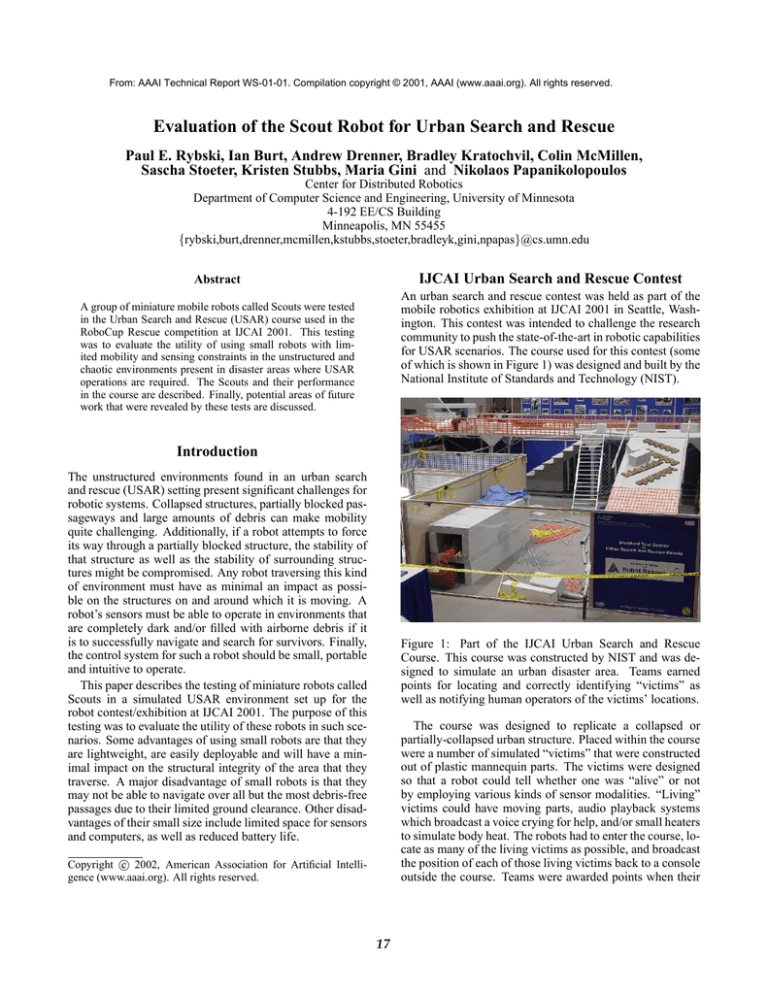
From: AAAI Technical Report WS-01-01. Compilation copyright © 2001, AAAI (www.aaai.org). All rights reserved.
Evaluation of the Scout Robot for Urban Search and Rescue
Paul E. Rybski, Ian Burt, Andrew Drenner, Bradley Kratochvil, Colin McMillen,
Sascha Stoeter, Kristen Stubbs, Maria Gini and Nikolaos Papanikolopoulos
Center for Distributed Robotics
Department of Computer Science and Engineering, University of Minnesota
4-192 EE/CS Building
Minneapolis, MN 55455
{rybski,burt,drenner,mcmillen,kstubbs,stoeter,bradleyk,gini,npapas}@cs.umn.edu
IJCAI Urban Search and Rescue Contest
Abstract
An urban search and rescue contest was held as part of the
mobile robotics exhibition at IJCAI 2001 in Seattle, Washington. This contest was intended to challenge the research
community to push the state-of-the-art in robotic capabilities
for USAR scenarios. The course used for this contest (some
of which is shown in Figure 1) was designed and built by the
National Institute of Standards and Technology (NIST).
A group of miniature mobile robots called Scouts were tested
in the Urban Search and Rescue (USAR) course used in the
RoboCup Rescue competition at IJCAI 2001. This testing
was to evaluate the utility of using small robots with limited mobility and sensing constraints in the unstructured and
chaotic environments present in disaster areas where USAR
operations are required. The Scouts and their performance
in the course are described. Finally, potential areas of future
work that were revealed by these tests are discussed.
Introduction
The unstructured environments found in an urban search
and rescue (USAR) setting present significant challenges for
robotic systems. Collapsed structures, partially blocked passageways and large amounts of debris can make mobility
quite challenging. Additionally, if a robot attempts to force
its way through a partially blocked structure, the stability of
that structure as well as the stability of surrounding structures might be compromised. Any robot traversing this kind
of environment must have as minimal an impact as possible on the structures on and around which it is moving. A
robot’s sensors must be able to operate in environments that
are completely dark and/or filled with airborne debris if it
is to successfully navigate and search for survivors. Finally,
the control system for such a robot should be small, portable
and intuitive to operate.
This paper describes the testing of miniature robots called
Scouts in a simulated USAR environment set up for the
robot contest/exhibition at IJCAI 2001. The purpose of this
testing was to evaluate the utility of these robots in such scenarios. Some advantages of using small robots are that they
are lightweight, are easily deployable and will have a minimal impact on the structural integrity of the area that they
traverse. A major disadvantage of small robots is that they
may not be able to navigate over all but the most debris-free
passages due to their limited ground clearance. Other disadvantages of their small size include limited space for sensors
and computers, as well as reduced battery life.
Figure 1: Part of the IJCAI Urban Search and Rescue
Course. This course was constructed by NIST and was designed to simulate an urban disaster area. Teams earned
points for locating and correctly identifying “victims” as
well as notifying human operators of the victims’ locations.
The course was designed to replicate a collapsed or
partially-collapsed urban structure. Placed within the course
were a number of simulated “victims” that were constructed
out of plastic mannequin parts. The victims were designed
so that a robot could tell whether one was “alive” or not
by employing various kinds of sensor modalities. “Living”
victims could have moving parts, audio playback systems
which broadcast a voice crying for help, and/or small heaters
to simulate body heat. The robots had to enter the course, locate as many of the living victims as possible, and broadcast
the position of each of those living victims back to a console
outside the course. Teams were awarded points when their
c 2002, American Association for Artificial IntelliCopyright gence (www.aaai.org). All rights reserved.
17
robots reported the location of victims back to a base station. While it was assumed that most of the robotic entries
would probably be teleoperated, teams with autonomous
robots were eligible for additional bonus points because of
the challenging nature of the course.
Related Work
Robots that are required to navigate through USAR environments will need the ability to handle complex terrain
and obstacles. Additionally, robots may need to manipulate their environment to remove debris from their path
or to open a passage. One solution to these problems
is to provide the robot with a set of manipulators, such
as arms or legs (Morse et al. 1994; Voyles 2000). Another solution is to make the robot extremely modular so
that it can change its shape for different locomotion and
manipulation requirements (Castano, Shen, & Will 2000;
Yim, Duff, & Roufas 2000).
In addition to sensors that will allow the robot to navigate, robots must be equipped with sensors that can detect
victims, such as digital cameras (visible light and thermal)
and microphones (Murphy et al. 2000). Other kinds of sensors that can be used to analyze the structural integrity of the
building are also important as they will help rescue workers
determine the safest course of action.
Some USAR applications may require fully teleoperated
control of a robot while others may benefit from more autonomous operation. Adjustable autonomy is a useful characteristic for a robotic controller, giving the robot operators
more flexibility in deciding how their robot will be used (Kortenkamp & Dorais 2000).
Figure 2: A collection of the Scout robots, including modified versions which have variable-sized wheels and low-light
illumination abilities.
Variable-Sized Wheel Scout
The Variable-Sized Wheel Scout is an augmentation to the
original Scout chassis design which allows it to control its
ground clearance. The wheels on this Scout use a mechanism similar to an umbrella to expand and collapse. By increasing the diameter of the wheels, shown in the center left
of Figure 2, the robot is able to drive over obstacles and holes
that might stop or trap a regular Scout. When the wheels are
collapsed, the Scout is the same height as a regular Scout
and can climb inclined surfaces as shown in Figure 3.
Scout Robots
Scout robots are miniature mobile robots 11 cm long and
4 cm in diameter. They are capable of driving over smooth
surfaces with their two differentially-driven wheels and they
have the ability to hop over obstacles 20 cm in height using their spring-loaded tails. At 200 g, Scouts are fairly
lightweight and groups of them can be carried by rescue
workers without difficulty. Scouts are designed to be handdeployed, thrown, or even launched into the operating area.
Figure 2 shows a group of the Scout robots.
Scouts are equipped with analog cameras coupled to
video transmitters allowing them to broadcast video data
to rescue workers. Commands are transmitted to the robot
via a digital RF channel that is independent from the video
channel. The Scouts’ small size limits the power of their
on-board computational resources. For teleoperated control, a Scout’s video signal is broadcast to a human operator,
who transmits motion commands back to the robot. For autonomous control, this video data can be received and digitized on a workstation for processing. Once the video is
processed, a decision process (such as a motion planner) analyzes the data, decides on the correct course of action and
transmits the appropriate commands to the Scout.
Figure 3: By collapsing the wheels, the Variable-Sized
Wheel Scout is able to climb inclined surfaces.
Scout Control
To provide teleoperated control of the Scout robots, a
portable controller has been developed. This controller contains a command radio and a video receiver and lets an op-
18
erator send the Scout actuator commands from a Palm Pilot.
The Scout’s video data is received by the controller and is
displayed to the operator through a head-mounted display.
Figure 4 shows an operator controlling the a Scout robot
with the controller. The operator does not need to be stationary when using the controller, and its internal batteries allow uninterrupted Scout operation over several hours. Commands can be broadcast to individual scouts by specifying
their unique identifiers. This particular wearable interface
does not allow the Scouts to function autonomously as there
is currently no way to digitize and process the video. Future
versions of the controller will contain an on-board PC and
framegrabber that will allow such operations.
floor which allowed more traditional research robots to operate without too much difficulty. The second (orange) course
had debris on the floor, passages that were partially blocked
and difficult to traverse, and a second level that could be
reached by a ramp or a staircase. The third (red) course
was strewn with rubble and had several “pancaked” structures. The orange course was chosen for the tests because
it provided a significant challenge to the diminutive Scouts
while still being accessible. The Scouts were able to easily
navigate through the yellow course because their small size
allowed them to drive under obstacles that were designed to
impede larger robots. The red course was avoided because it
is unlikely that the Scouts would be of much use for locating
or identifying survivors in such an environment. However,
if the Scouts were deployed into the environment as stationary cameras, they might still be useful as monitors to detect
structural instabilities such as shifting debris.
The capabilities of the basic (fixed-wheel size) Scout
model were tested first. The Scout was teleoperated by a
user wearing the portable PDA controller. The entry to the
course consisted of “cracked” floorboards (wooden plates
which had separations that could trap the Scout if it fell
into them) which were covered with paper debris. To enter the course, the Scout had to jump over a door threshold
and then do several more jumps to move past the separations
in the floorboards, as shown in Figure 5. At one point, the
Scout accidentally fell into one of the cracks and was unable
to use its wheels to free itself due to the limited mechanical
advantage it had in this position. The Scout was able to use
its spring foot to propel itself out of the hole and back onto
flat ground, as shown in Figure 6. The remainder of the first
floor was relatively accessible as the Scout could jump over
the additional debris. The second floor of this level was not
accessible to the Scout as it was unable to get enough traction to scale the ramp and it was unable to reach the stairs
(so it could jump up them) due to additional debris in front
of it.
The capabilities of the Variable-Sized Wheel Scout were
tested next. With the wheels fully expanded, the Scout had
no difficulties traversing the entry way and was able to roll
right over the crack between the floorboards that trapped the
first Scout. The rest of the obstacles in the environment were
easily driven over, as shown in Figure 7. By contracting
its wheels to their minimum diameter, the Scout was able
to scale the beginning part of the ramp to reach the second
story, but was unable to reach the top due to obstacles over
which its motors didn’t have enough torque to climb. However, if placed at the top and commanded to descend the
ramp, the Scout was able to climb over these obstacles in
a controlled fashion (shown in Figure 8).
In both sets of experiments, the operator was able to view
the video returned from the Scout and find several of the
simulated victims. The small viewing angle of the Scout’s
camera and the close proximity of the robot to the floor made
this task somewhat more challenging than originally anticipated. In the initial runs, the operator had a tendency to
become disoriented because of the Scout’s low field of view.
However, with additional runs, the operator became more
proficient at the teleoperation task.
Figure 4: An operator controlling a Scout using a PDA.
Scout Testing in the USAR Course
The Scout’s small size and remote operation capabilities
give it the potential to be very useful in USAR operations.
However, this small size is also a liability in environments
with places in which the robots could easily become trapped.
RF communications range is also likely to be diminished due
to the amount of rubble and debris between the robot and the
operator. The Scouts were run through the NIST course to
evaluate how well they might perform in a simulated USAR
environment. The NIST course actually consisted of three
different courses of increasing difficulty. The easiest (yellow) course consisted of a relatively flat and uncluttered
19
1
2
3
4
5
6
Figure 5: A Scout using its spring to avoid a hole in the floor.
1
2
3
4
5
6
Figure 6: A Scout using its spring to free itself from a hole in the floor.
20
1
2
3
a
b
c
Figure 7: The Variable Sized Wheel Scout traversing two different obstacle sets on the floor.
1
2
3
4
5
6
Figure 8: The Variable Sized Wheel Scout traversing obstacles on a ramp.
21
Summary & Future Work
autonomous behaviors were evaluated at IJCAI because the
wearable controller used for these tests did not have an onboard computer capable of capturing and processing the
video. Some of these behaviors, detailed in (Rybski et al.
2001), include autonomously moving the Scout into an area
that is conducive for surveillance, and reporting if any motion is detected from within that area. The next phase of development would be to try to tune these behaviors such that
they can be used in an USAR environment. This will provide more flexibility to human operators since they would be
able to teleoperate one or two robots directly while allowing
the other robots to autonomously perform simple tasks like
navigating between waypoints or homing in on motion or
noise.
Because the Scouts were untested in this kind of environment before they were used at IJCAI 2001, they were not entered into the competition. Instead, they took part in the exhibition and were allowed to operate within the arena when
other robots were not competing.
These tests suggest that the Scouts could be useful in
certain kinds of disaster situations. Because of their small
size, the Scouts could operate within the yellow and orange
courses because these courses simulated buildings that were
mostly intact. The main challenge to their mobility was the
debris and holes on the floor which they were usually able to
jump or climb over. Given a favorable environment of this
type, where most of the structures are still intact, additional
reliability could be achieved by deploying multiple Scouts.
If one robot becomes stuck or disabled, another robot could
continue the operation where the first left off.
Another of the challenges faced during the tests was the
noisy RF environment in which the Scouts had to work. Because there many other teams participating in the robotic
competitions and exhibitions (as well as the RoboCup soccer
competition taking place in the adjacent hall), some RF frequencies that the Scouts used were either partially corrupted
with interference or rendered completely unusable. In particular, some of the video transmission frequencies that the
Scouts used were also being used by the other teams for
wireless networking.
Operating in a noisy RF domain is a challenge that must
be addressed for any USAR robot because rescue two-way
radios and other RF equipment are likely to be used quite
heavily by rescue personnel at a disaster site. An area of
future research for the Scouts is to provide more frequency
agility in the RF communications system either by providing
more channels for the robots or making use of a frequencyhopping RF system. The dependence on clean data communications channels is one of the tradeoffs that must be made
when using robots of this small size.
Additional means of Scout locomotion are also being examined. The close proximity of the Scout to the ground
greatly restricts its field of view, as well as making it more
susceptible to being caught in debris. One area of future
work is a grappling hook modification for the Scout. A
Scout equipped with a spring-loaded grappling hook might
be able to increase its field of view by firing the hook into
the ceiling of a structure and then lifting itself up. Another
method of mobility currently being researched is a blimp attachment which would be able to lift the Scout up and over
damaged structures and provide an aerial view of an area.
Because the only exteroceptive sensor on the Scout is a
video camera, the Scout’s video can be rendered useless by
bad lighting conditions. In a USAR scenario no assumptions about the existence of good lighting can be made. To
address this problem, a Scout equipped with an external battery pack and infrared LEDs is being developed. This Scout
is designed to illuminate an area with infrared light (to which
the Scout camera is sensitive) allowing it and other Scouts
to see in the dark.
Finally, the use of autonomous or semi-autonomous behaviors for this kind of operation is being researched. No
Acknowledgements
We would like to acknowledge American Association for
Artificial Intelligence for the AAAI Robot Competition and
Exhibition Scholarship that allowed us to bring our robots to
AAAI 2001 in Seattle, WA.
Material based upon work supported by the Defense Advanced Research Projects Agency, Microsystems Technology Office (Distributed Robotics), ARPA Order No. G155,
Program Code No. 8H20, issued by DARPA/CMD under
Contract #MDA972-98-C-0008.
References
Castano, A.; Shen, W.; and Will, P. 2000. Conro: towards
deployable robots with inter-robot metamorphic capabilities. Autonomous Robots 8(3):309–324.
Kortenkamp, D., and Dorais, G. 2000. Tutorial: Designing human centered autonomous agents. In PRICAI Pacific
Rim Intenational Conference on Artificial Intelligence.
Morse, W.; Hayward, D.; Jones, D.; Sanchez, A.; and
Shirey, D. 1994. Overview of the accident response mobile manipulation system (armms). In Proceedings of the
ASCE Speciality Conference on Robotics for Challenging
Environments, 304–310.
Murphy, R.; Casper, J.; Hyams, J.; Micire, M.; and Minten,
B. 2000. Mobility and sensing demands in USAR (invited).
In IECON.
Rybski, P. E.; Stoeter, S. A.; Gini, M.; Hougen, D. F.; and
Papanikolopoulos, N. 2001. Performance of a distributed
robotic system using shared communications channels.
Technical Report 01-031, University of Minnesota Computer Science and Engineering Department.
Voyles, R. M. 2000. Terminatorbot: A robot with dualuse arms for manipulation and locomotion. In Proc. of the
IEEE Int’l Conf. on Robotics and Automation, volume 1,
61–66.
Yim, M.; Duff, D. G.; and Roufas, K. 2000. Modular reconfigurable robots, an approach to urban search and
rescue. In 1st Intl. Workshop on Human-friendly Welfare
Robotics Systems, 69–76.
22





